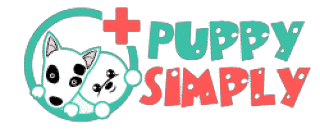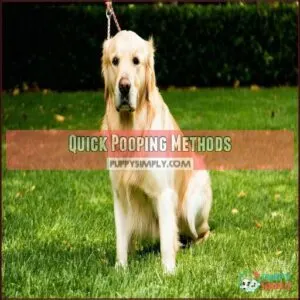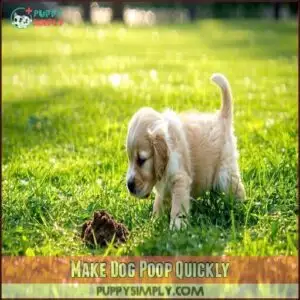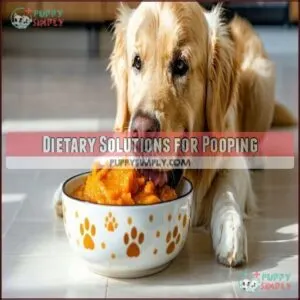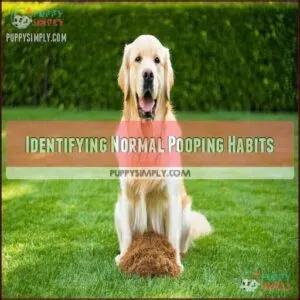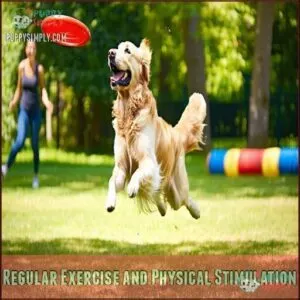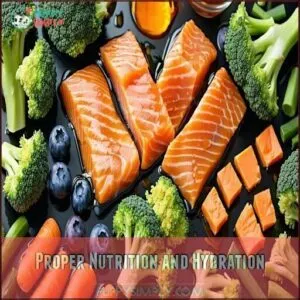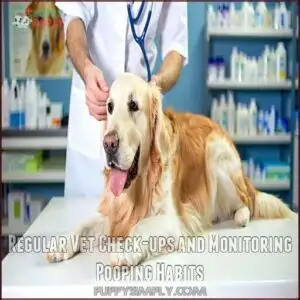This site is supported by our readers. We may earn a commission, at no cost to you, if you purchase through links.

Start with a gentle belly massage, rubbing in circular motions to get things moving. A quick walk can also work wonders; activity often triggers bowel movements.
For a more hands-on approach, try gently wiping your dog’s bottom with a cool, damp cloth—it mimics what their mom did as puppies. In a pinch, an ice cube applied briefly to the area might help.
Always make sure your pup’s hydrated and getting enough fiber in their diet. A little effort now saves big cleanup later, and using these methods can be a quick solution.
Table Of Contents
- Key Takeaways
- Quick Pooping Methods
- Make Dog Poop Quickly
- Long Term Pooping Strategies
- Dietary Solutions for Pooping
- Recognizing Constipation Signs
- Preventing Future Constipation
- Frequently Asked Questions (FAQs)
- How to make a dog poop quickly?
- How can I harden my stool?
- How to make a dog poop when constipated?
- How do you teach a dog to poop?
- How can I Help my Dog poop fast?
- How to make a dog poop with a match?
- What will make a dog poop right away?
- How can I make my constipated dog poop faster at home?
- How do I Stop my dog pooping in the bathroom?
- How do you stimulate a dog to poop?
- Conclusion
Key Takeaways
- Take your dog for a brisk walk or playtime to stimulate their digestive system.
- Massage their belly gently in a circular motion to promote bowel movement.
- Use a damp, cool cloth or wet wipes on their rear to trigger defecation reflexes.
- Add fiber-packed foods like pumpkin to their diet and keep them hydrated for smoother digestion.
Quick Pooping Methods
When your dog’s taking forever to do their business, you need quick tricks to speed things up.
From belly rubs to cool water, these methods can help your pup get moving in no time, with quick tricks being essential for a swift resolution.
Massaging Dog’s Belly
When your dog’s stubborn belly won’t budge, try massaging it to get things moving.
Use gentle pressure to stimulate peristalsis and provide bloat relief. Here’s how:
- Gently rub in a circular, clockwise motion.
- Combine the massage with soft belly pats for encouragement.
- Repeat the Puppy Massage process a few times to help your dog poop quickly.
Using Wet Wipes or Cool Water
To encourage a dog to poop quickly, gently use wet wipes or cool water on their bum. This mimics licking stimulation, activating the defecation reflex.
Warm water can also aid dog constipation relief. A great way to keep your dog clean is to use pet-safe dog wipes.
| Technique | Purpose | Notes |
|---|---|---|
| Wet wipes | Bum cleaning | Use gentle, pet-safe wipes. |
| Cool water application | Stimulation methods | Comfortable water temperature. |
| Warm water soak | Dog poop water stimulation | Avoid overly hot water. |
Applying Ice Cubes
Sometimes, when your dog won’t poop, an ice cube can save the day.
Gently rub it around their anus to stimulate a bowel movement—think of it as a little nudge for the digestive system.
Dog size matters, though; smaller dogs may need softer techniques.
Always consider Ice Cube Risks, consulting a vet for chronic dog constipation or alternative stimulants.
The Matchstick Trick
If ice cubes aren’t your thing, the matchstick trick can stimulate dog poop quickly.
Moisten a matchstick, gently insert it into the dog’s rectum, and wait. This method mimics natural instincts, encouraging a bowel movement.
But safety first—use proper technique, watch for potential risks, and consider veterinary alternatives. It’s effective but should be an ethical option, and used as a last-resort.
Make Dog Poop Quickly
Getting a dog to poop quickly can feel like a race against time, especially during cold nights or busy mornings.
Helping your dog poop fast is all about patience, belly rubs, and finding the perfect potty spot—stay calm and consistent!
If you’re stuck, remember these tricks. Safe stimulation, like gently massaging their belly, can help digestion speed along and induce a bowel movement. Wet wipes on their bum might mimic a mom’s lick, triggering their reflexes.
Is your pup a bit picky about potty spots? Location matters—taking them somewhere familiar reduces routine disruption. Walking them often encourages movement too.
Sometimes, a quick squat in the right spot feels like finding buried treasure! Keep calm and stay patient. Dogs pick up on stress, which can slow things down. With these tips, you’ll tackle poop urgency like a pro!
If straining lasts too long, consider potential constipation.
Long Term Pooping Strategies
Helping your dog poop faster long-term starts with training and consistency.
By building good habits, like using commands and offering rewards, you’ll make potty time easier for both of you.
Establishing Consistent Routine
Consistency is key when establishing a dog poop routine.
Stick to a schedule to make life easier for you and your furry friend:
- Plan Scheduled Potty Breaks after meals and naps.
- Maintain Predictable Walk Times daily.
- Use Consistent Feeding schedules for regular digestion.
- Pick a Designated Poop Spot for familiarity.
Understand how Routines Impact behavior—dogs thrive on predictability!
Using Commands and Clicker Training
When teaching a dog poop command, pair simple words like "go potty" with a consistent potty spot.
Use clicker reinforcement the moment they poop to create a positive pooping association.
Stick to patience and consistency—dogs learn over time.
Dog clicker training, combined with a reward system, strengthens your dog poop training routine and reduces frustration.
Offering Treats and Rewards
Timing matters when using dog treats to encourage pooping quickly. Bring along a treat variety your dog loves as motivation.
Use positive reinforcement by rewarding them the moment they poop. If treats don’t work, reward alternatives like extra playtime might do the trick.
Consider using high-value training incentives to increase motivation. Finding what drives your dog’s motivation levels is key to effective dog poop training, and using the right incentives can make a significant difference.
Being Calm and Patient
Patience pays off when dealing with dog poop problems. If your dog won’t poop, avoid rushing or adding stress.
Your calm energy helps reduce anxiety, creating comfort and building trust. Stand still, relax, and let your dog sniff around—it’s their way of finding the perfect spot.
Positive reinforcement works wonders here, so praise success warmly! Teaching your dog a settle command can further reduce anxiety.
This approach helps build trust between you and your dog, leading to a more harmonious and stress-free experience when dealing with dog poop problems.
Dietary Solutions for Pooping
What your dog eats plays a big role in how easily they can poop.
With the right mix of fiber, hydration, and tasty options like canned food or pumpkin, you can get things moving in no time.
Feeding Canned Food
Canned food works wonders when your dog’s digestive system needs a nudge.
Its high moisture content hydrates and softens stools, making it easier for your furry friend to go. Plus, dogs love the taste! Just watch portions to avoid overfeeding.
Focus on quality canned dog food to support dog digestive health and tackle dog constipation effectively.
- Benefits: Hydration and stool softening
- Moisture Content: Aids digestion
- Palatability Concerns: Dogs enjoy it
- Portion Control: Avoid overfeeding
- Constipation Relief: Promotes regularity
Adding Leafy Vegetables and Fruits
Leafy vegetables like spinach and kale or dog-friendly fruits like blueberries and watermelon can power up your pup’s pooping routine.
They’re packed with fiber benefits that keep digestion smooth and stomaches happy.
Don’t overdo portion sizes, though—start small to avoid messy surprises.
Pumpkin for dog constipation? That’s a classic! Fiber and hydration boost? Consider it handled with these tasty choices.
Providing Adequate Hydration
Dogs can get constipated if they’re dehydrated, so boosting their water intake is key.
Boost your dog’s hydration with fresh water, broth, or playful ice cubes to keep their tummy happy and pooping smooth!
Always make certain clean water is available, and try adding low-sodium chicken broth to meals—it’s tasty and hydrating! Another trick is using ice cubes as a fun, crunchy treat.
- Serve low-sodium chicken broth for hydration benefits.
- Offer ice cubes as a playful way to hydrate.
- Monitor electrolyte balance to avoid dehydration risks.
Adding Fiber and Probiotics
Adding fiber and probiotics can work wonders for your dog’s digestion.
Fiber benefits include smoother pooping and reducing dog constipation.
Try dog pumpkin or dog fiber supplements for natural solutions.
Probiotic types like powders or capsules boost good bacteria.
Consider using dog fiber products to improve your dog’s health.
Focus on supplement safety—check dosage guidelines with a vet.
Long-term use promotes better pooping habits and overall gut health!
Recognizing Constipation Signs
You’ll know your dog may be constipated if they’re straining, producing little to no poop, or seem uncomfortable.
Paying attention to their normal bathroom habits helps you spot when something’s off, so you can act quickly.
Identifying Normal Pooping Habits
Knowing your dog’s normal pooping habits is essential for their health.
Key factors to monitor include:
- Stool Consistency: Firm but not hard is ideal.
- Poop Frequency: Once or twice daily is typical.
- Color Variations: Healthy stools are brown.
- Volume Analysis: Matches food intake.
Stay observant, as patterns reveal a lot about dog poop routine and overall digestion.
Recognizing Abnormal Pooping Patterns
When your dog won’t poop, watch for warning signs.
Straining, appetite changes, or dry stool consistency could mean trouble.
Blood detection in poop or a drop in poop frequency might hint at dog constipation signs.
Need a quick checklist? Here’s one:
| Symptom | What to Look For | What It Could Mean |
|---|---|---|
| Straining Signs | Struggles to poop | Potential constipation |
| Stool Consistency | Hard or dry stools | Dehydration possible |
| Appetite Changes | Eating less, lethargy | Digestive health issue |
Don’t ignore the signs—your companion is counting on you to identify potential constipation and take action to address dehydration possible issues, ensuring the well-being of your dog by monitoring stool consistency.
Factors Affecting Bowel Movements
Stress, routine, and diet are big players in your dog’s bathroom habits.
A stressed pup or one lacking fiber could have issues pooping. Got a picky pooper? Surface type matters too!
Watch for these factors:
- Dietary Impact: Poor food quality slows dog digestion.
- Hydration Levels: Dehydration hardens stools.
- Exercise Influence: Lack of movement disrupts flow.
- Stress Factors: Anxiety stalls pooping.
- Medical Conditions: Constipation signals health trouble.
Preventing Future Constipation
You can keep your dog’s tummy trouble-free with simple habits like proper exercise, hydration, and a balanced diet.
Regular check-ups with your vet will also catch any issues before they become a pain in the rear—literally.
Regular Exercise and Physical Stimulation
Regular exercise keeps your dog’s digestive health in check, like oil in an engine.
Walking, playing fetch, or short runs boost dog digestion and stimulate bowel movement.
Tailor your dog exercise routine to their breed differences and activity levels.
It’s simple: what energizes their tail-wagging also keeps their tummy happy!
Many owners invest in specialized agility equipment to keep their dogs active.
| Activity | Duration | Frequency |
|---|---|---|
| Short walks | 15-20 minutes | Twice daily |
| Fetch/Playtime | 10-15 minutes | Thrice weekly |
| Light jogging | 10-20 minutes | Twice weekly |
Proper Nutrition and Hydration
Feeding your pup right keeps their tummy happy and poops on schedule. A balanced diet works wonders!
Try these tips:
- Mix canned food with meals for moisture.
- Add fiber sources like pumpkin or dog-safe veggies.
- Serve juicy fruits like watermelon for hydration.
- Use hydration methods, like adding broth to food.
A well-fed dog is a pooping pro! Occasional soft stools are normal, but persistent issues could indicate an unbalanced gut microbiome, which may require attention to achieve a healthy gut.
Regular Vet Check-ups and Monitoring Pooping Habits
Don’t wait until things go south—work with your vet to track stool consistency, frequency, and bowel movement changes.
Regular check-ups allow for early detection of dog constipation or health issues. Preventative care makes a big difference!
| Check-Up Frequency | What to Monitor | Vet Communication Tips |
|---|---|---|
| Twice a Year | Stool Consistency | Ask about diet adjustments |
| Quarterly (Senior Dogs) | Frequency Tracking | Share bowel movement logs |
| Immediately (If Issues) | Abnormal Symptoms | Report changes promptly |
To ensure the best care for your dog, it is essential to follow these guidelines and maintain open communication with your vet, focusing on early detection and regular check-ups.
Frequently Asked Questions (FAQs)
How to make a dog poop quickly?
Take your pup for a brisk walk, as exercise stimulates digestion.
Massage their belly gently in circles, or use a damp wipe on their rear.
A little patience and encouragement work wonders—no need to rush!
How can I harden my stool?
To firm up your stool, boost fiber with foods like bananas or rice, stay hydrated, and avoid greasy meals.
Stress can also upset your gut, so kick back and relax—it’s gut-friendly advice!
How to make a dog poop when constipated?
When your dog’s constipation turns their bathroom breaks into staring contests, try canned pumpkin or extra water for quick relief.
Gentle belly rubs and a quiet spot can also work wonders.
When in doubt, call a vet.
How do you teach a dog to poop?
Teach your dog to poop on command by establishing a routine.
Use a clear cue like "go potty," and rewarding success with lots of praise or treats.
Stay consistent, patient, and keep it fun!
How can I Help my Dog poop fast?
When nature calls but won’t answer, try a belly rub or a short walk to get things moving.
Pumpkin, wet wipes, or even a calm, quiet spot can work wonders for quick relief.
How to make a dog poop with a match?
Gently moisten a matchstick, then carefully insert it just inside the dog’s anus for a few seconds.
This stimulates the defecation reflex.
Use caution, stay calm, and make certain your dog isn’t distressed during the process.
What will make a dog poop right away?
Think of it like jump-starting an engine—walk your dog briskly, massage their belly in clockwise circles, or use a damp wipe on their bum.
These tricks can trigger quick results, often within minutes!
How can I make my constipated dog poop faster at home?
Massage your dog’s belly in circles, offer canned pumpkin for fiber, and try a quick walk to get things moving.
If they’re still stuck, a cool wet wipe on their bum might help!
How do I Stop my dog pooping in the bathroom?
Did you know dogs poop an average of 1-5 times daily?
To stop bathroom accidents, establish a potty schedule, supervise breaks, and reinforce outdoor pooping with treats.
Consistency’s key—dogs love reliability (and snacks).
How do you stimulate a dog to poop?
Take your dog on a brisk walk, which naturally stimulates their digestion.
Try rubbing their belly in circular motions or use a wet wipe gently on their bum to trigger the pooping reflex—works like magic!
Conclusion
When your dog’s doing the poop dance like it’s a high-stakes game, these tricks can save the day.
Massage their belly, take a brisk walk, or try a damp cloth to get things moving.
Stick to a good diet with fiber and hydration for long-term success.
You’ll both be less stressed, and your pup will stay happy and healthy.
Remember, knowing how to make a dog poop quickly isn’t just handy—it’s a dog owner’s secret weapon!
- https://pubmed.ncbi.nlm.nih.gov/19217105/
- https://www.petmd.com/dog/slideshows/general_health/top-ten-health-benefits-walking-your-pet-provides
- https://www.highlandpethospital.net/breeders-info/neonatal-puppy-care/puppy-care/
- https://frontiersinzoology.biomedcentral.com/articles/10.1186/1742-9994-10-80
